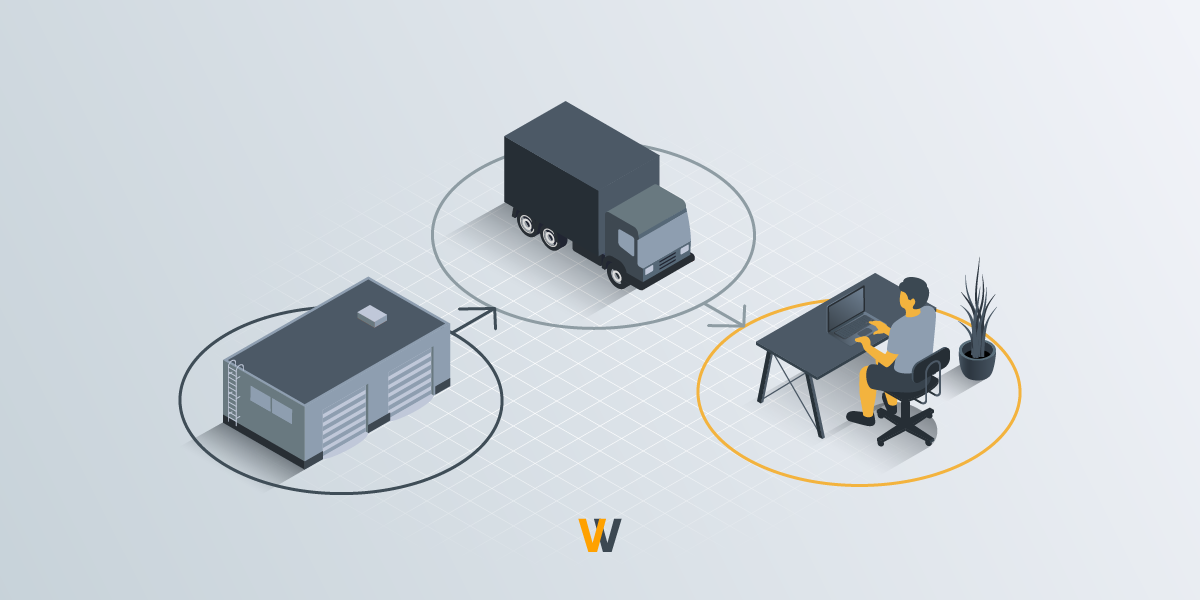How to set up a remote distributed team in 30 days
 GroWrk Team
GroWrk Team
As some companies start to open their doors to employees again, others may be wondering how to set up a remote distributed team. After switching to remote work, 86% of employees felt less stressed, and 69% of millennials would give up some of their benefits to maintain a flexible work environment.
By 2028, 73% of all departments could be reporting to work from a distributed team model. During this last year, many companies had to switch their departments or teams to a distributed format. There are other new companies that are just launching this year and only want remote working. So, if this is the future and employees are satisfied, why switch back?
Remote work is sustainable. Setting up a distributed team for the long run may seem like a daunting task at first, but it can be streamlined, especially if you already have people working remotely. With the proper dedication, tools, and guidance, you can set up a remote distributed team in 30 days.

What are distributed teams?
A distributed team consists of company employees who do not physically work together but collaborate on the same tasks.
Distributed Vs. Co-located Teams
While a distributed team will have employees who work together from different locations, typically, they will have one or two team members in a managerial role at a centralized location. A co-located team is the opposite. They all work together in the same physical space.
With co-located teams or office employees, you have the advantage of more frequent and intimate interactions, making it easier to communicate and build solid relationships. However, you are also limiting the talent pool for your team because you’ll have to find an employee who can commute to your office space.

Distributed teams can be assembled internationally, giving you a global pool of remote talent to select from. They also bring unique perspectives and experiences with them. However, encouraging regular team communication and team building can be challenging in a distributed environment. Everyone will have to learn asynchronous communication to perform effectively.
In terms of collaboration, distributed and co-located teams aren’t all that different. They still need to exchange information and create action through the proper channels. A remote team member in both formats needs to be informed of the work and progress of their peers. They also need to use collaboration tools like Google Drive or Microsoft Teams.
What does it mean to work in a distributed team?
Distributed teams have similar expectations to co-located teams but with a few more obstacles to overcome.
A successful distributed team manager is the glue that holds it together. They have everyday team leader responsibilities like assigning tasks and communicating with upper management. However, they also need to ensure all distributed team members are up to speed and on the same wavelength.
The lack of physical interaction means that many critical points and essential information can go unsaid. Therefore, a remote worker needs to be adept at written communication and conveying all necessary information succinctly and precisely. They also must learn the basics of asynchronous communication which is basically the practice of leaving messages for your team to read on their own time. Like sticky notes!
Working on a distributed team means that you’ll be interacting with individuals who are from different locations, sometimes even countries. Distributed team members need to be aware of the physical and cultural barriers between them, understanding and respecting lifestyle differences.

A distributed company needs to be just as accommodating for a member from Bangladesh as they are for a Canadian. Otherwise, they’re missing out on one of the greatest advantages of distributed work: bringing different perspectives to the table.
Whether someone needs to be off for a special holiday or their morning is your evening, teams need to be flexible enough to adjust to these changes on the fly. Thus, being agile is another vital element of any distributed workforce.
How to set up your remote distributed team:
Days 1 - 7
The first week of remote distributed team setup is about building a remote infrastructure where your team members can succeed. You need to lay down the foundation for all remote workforce interactions so they are frequent enough and everyone has the right tool for every task.
This process begins with defining a management structure and adopting an advanced technology stack.
Management structure
On a distributed team, the manager will collect deliverables and ensure they’re completed on time. They do so by using task tracking or a project management tool to keep people on task and provide feedback when necessary.
While working hours are flexible for distributed teams, remote team conference calls should not be. The team standup meeting cadence needs to be regular and frequent, so no vital information is lost. Managers can also use these meetings as an opportunity to check in on the staff, seeing how everyone is doing personally and professionally, and offer their assistance to those who are struggling.
The appropriate meeting cadence for a distributed team should be between two to three times a week. You’ll have to analyze your team members’ preferences and how much information they’re willing to give. Too often, and they will grow bored with the remote meetings. Too infrequent, and people will lose track of projects and relevant information.
The technology and top tools for your distributed team
The technology stack your distributed employees utilize will be the bridge between them, their team, and the company. Your company will need advanced software for IT asset management, communication, project management and HR.
For communication, you need software that is trustworthy and has everything in one place. For example, employees switching between email and video conferencing applications will waste time and lower their motivation to convey smaller bits of information. Slack is a great communication channel because you can just as quickly send an email, add comments to an assignment, and video call in one window.
Project management requires a comprehensive tool that allows people to easily see each other’s work, the main projects of the company, and their own assignments. Tools like Monday.com and Asana are great at keeping track of remote workers because they allow individuals to comment, give feedback, and mark assignments as completed.
New remote team members will also require equipment. While some may have hardware of their own, many will need to be outfitted so they can work to the best of their ability. Many companies provide stipends for eShops to solve this problem, but we recommend using GroWrk. They are an equipment distribution platform that can send laptops and devices to your remote team member no matter where they are in the world.

Finally, your HR staff will need some software of their own to assist your remote team. A payroll software like Deel or Remote Teams is excellent because they have legal teams to assist you with paying workers internationally. They’ll also benefit from onboarding software.
Companies like Lessonly and Skyprep have fantastic services where HR staff and team members can record training and introduction videos to streamline the onboarding process.
How to set up your remote distributed team:
Days 7 - 21
The first week of setting up a remote distributed team is about preparing the remote environment for your employees. The following two weeks are about setting the entire team up for success.
Equipment Logistics
As we mentioned earlier, GroWrk is the perfect medium for distributing equipment to your remote workers. They operate in over 150 countries and handle shipping themselves. That means you won’t burden your HR staff with the chore of finding a company that sends Macbooks to Saskatchewan.
%204.26.29%20p.%20m..png?width=960&height=504&name=Captura%20de%20pantalla%202024-04-18%20a%20la(s)%204.26.29%20p.%20m..png)
They have a wide selection of devices which all come with remote management software and hardware-based VPNs for maximum security and compliance. Their technology is from the most recent generation of leading brands like Apple and Lenovo.
They’re perfect for companies who want to quickly set up a distributed team because they can ship equipment around the world within a 7-day period and only require monthly payments to get started. As soon as it arrives, your remote employees are ready to begin working and if they run into a problem there is a 24-hour help desk.
If you’re not sure what equipment your remote team members need, try offering them a survey. You can see what everyone has and what they want. Then, use these results to set a budget for your employees. You can even put some recommended or mandatory items from the GroWrk catalog.
Pre-boarding New Remote Team Members
The onboarding process for teleworkers involves a few more steps than for co-located employees. It’s not as simple as your HR staff and team members sending over a few training videos. The following steps outline the full preboarding process:

- HR staff emails them their contract.
- Ensure that it meets all legal guidelines in the employee’s country as well as your own.
- Send them all the relevant company information like time schedules, pay structure, and your mission statement.
- Also, send them a copy of the company handbook to get an idea of the positive company culture.
- HR staff introduces them to their teams and assigns them virtual buddies.
- Virtual buddies are team members or managers who help with the onboarding process. They lend a helping hand and answer specific questions related to the team’s work.
- Assign an easy project/task to get them started while not being overwhelmed.
After you finish these steps, you can schedule a one-on-one meeting with the employee and their manager to finish the onboarding process.
Virtual 1:1s
A virtual one-on-one is when a new employee has a virtual meeting with the company’s leader, manager, or the HR staff one more time to finalize the onboarding process. On their first day set up a time to create a 30, 60, or 90-day plan that will solidify and mark the end of their onboarding process.
After the plan and their goals are set, the new remote employee will have the opportunity to ask any questions and request clarification. It’s also an excellent time for them to suggest feedback for the remote company.
Then, once you and the new employee feel comfortable, you can turn them over to their team manager for a one-on-one session of their own.
The team leader can clarify responsibilities during this meeting and define the employee’s specific role in the team. After they’ve exchanged all the information, they can assign the employee’s first task.
How to set up your remote distributed team: Days 21 - 30
About three weeks into setting up your remote distributed team, you’ll begin to realize where you’ve succeeded and where you need improvement. You’ll have statistics on employee deliverables and efficiency. You’ll also have employees with valuable information to share about their experience on your distributed team.

Feedback Sessions
The first person you should contact for feedback is your team leaders and managers. They will have a broader perspective of the remote work process and will be able to tell you what’s working and what isn’t. It’s also more likely for individual team members to be honest with them about their problems than upper management or HR.
After you finish with the managers, you can move on to questioning employees. Again, be sure to phrase questions precisely and apply a rating system. For example, scaling satisfaction about “remote communication software” from one to five is a lot more effective than asking, “do you enjoy your virtual meetings, yes or no?”
You can also encourage employees to provide feedback to one another and monitor these channels. Creating a company email thread or a slack group chat for complementing great work is a good place to start. You can do the same with a “questions” channel to assist anyone who is struggling.
Once you get the feedback, you must implement changes immediately. Remote teams need to maintain an open and honest line of communication. Employees whose feedback isn’t quickly addressed will feel ignored and underappreciated.
Reporting on Tasks/Projects Completed
Beyond feedback from your employees, you can also use your task tracker to see how well your distributed team performs. If one group or task is failing, you can schedule a meeting with the team leader or those specific employees.
Always set a goal before reviewing this information. Figure out a target that you want to achieve so you can see if you’re on pace. All numbers are subjective, and without an overall goal, they can shift them in either a positive or negative direction regardless of the actual results.
Virtual Team Get-Together or In-Person Vaccinated Meet-Up
We surveyed the benefits 100 companies provided for their remote teams. One of the most common benefits in that survey was an annual or biannual in-person meet-up with the entire company. This information came as no surprise. Building strong personal relationships between team members is essential to a successful workforce.
The end of the first month is a fantastic opportunity to gather everyone together, have them reflect on the work they’ve done, and informally strategize for the future. Seeing each other’s faces outside of working hours will help your employees feel more connected and open when communicating in the future.
In-person is the best way to do this, but you can also have a virtual gathering to bring your remote team closer together.
You can organize a team building activity like home office bingo or discussions about stress and balancing professional and personal lives. Overall, exchanges like this will help eliminate the physical barriers between your team and show them their coworker's personalities, not just ghosts behind a computer screen.

How to Deal with Challenges When Your Team is Distributed
Like any other team, leading and managing a distributed teams has its challenges. Unfortunately, many managers experienced these challenges firsthand when forced into a remote format by the COVID-19 pandemic.
Some of the most common challenges to dealing with a distributed team are:
- Trusting team members to perform independently
- Avoiding micromanaging whenever possible
- Getting all the details for projects and tasks
- Maintaining and engaging work environment
- Coordinating information exchanges
In the end, these challenges boil down to two things: communication and trust. Distributed team leaders need to find a balance. They need to trust their team members to be independent and maintain an open line of communication so help can be provided when necessary.
The best way to address these challenges is by knowing your team leaders and managers and encouraging them to be upfront and honest with you. Encourage them to learn people’s strengths and weaknesses, so they can always get the best employee for every task.
Make it clear that this is a learning experience for everyone, and you are all growing together. Most importantly, don’t shame people when mistakes are made.

Engaging Globally Distributed Teams Through Collaborative Environments
If your team is distributed over international borders, you need to treat it as an advantage instead of an obstacle. Individuals working in different countries bring unique perspectives and ideas that people in your home country may never have considered.
One way to encourage positive exchanges is by discussing cultural differences. Don’t be afraid to start a meeting with “How is the weather in Finland today?” or “How do they celebrate birthdays in Japan?” Asking and showing genuine interest in everyone’s unique lifestyle will encourage your employees to do the same. It will also let everyone know how their distributed team members maintain their work-life balance.
These types of interactions also make everyone have more of an identity. People identify with more than just their position at the company. Bringing these personal details into the light can humanize the conference room and encourage more collaboration.
Wrapping Up
The world of business is shifting into a remote format. Your company does not need to be left behind. While the process is complex, you can quickly set up a distributed team. Don’t let challenges along the way discourage you. Rome was not built in a day, but you could build your distributed team in 30!






